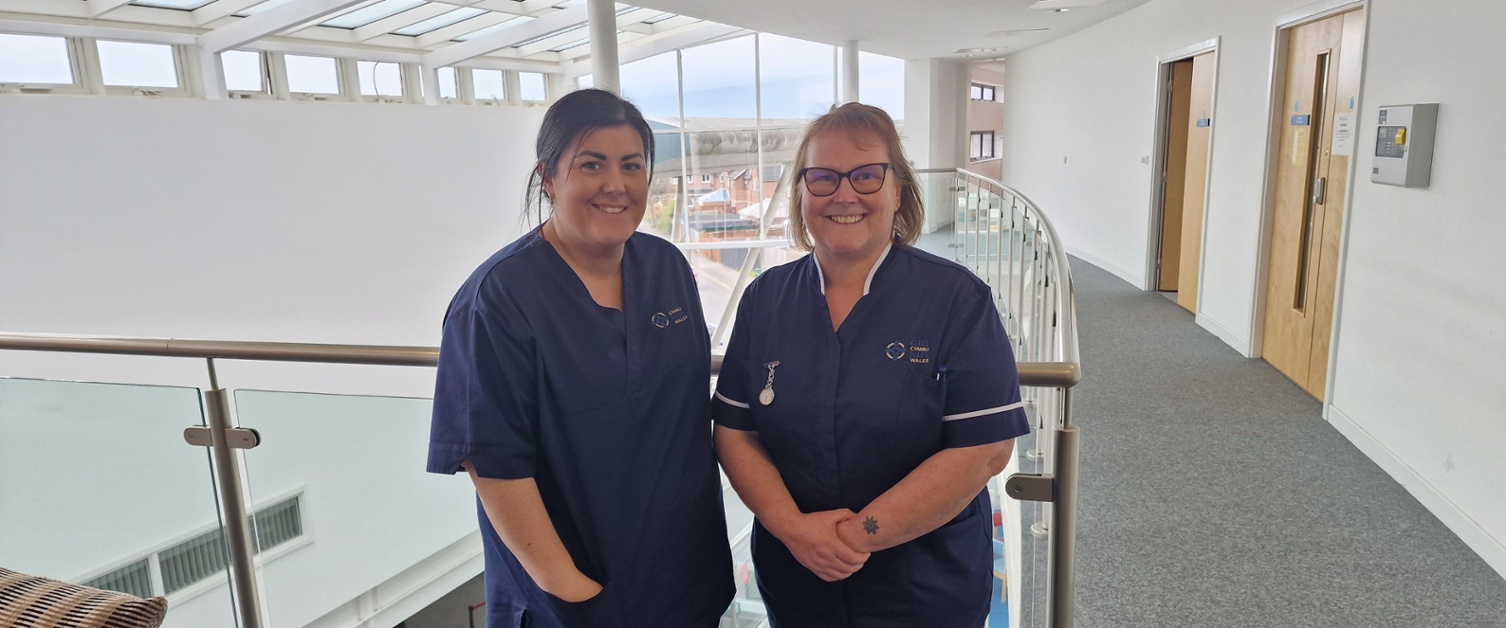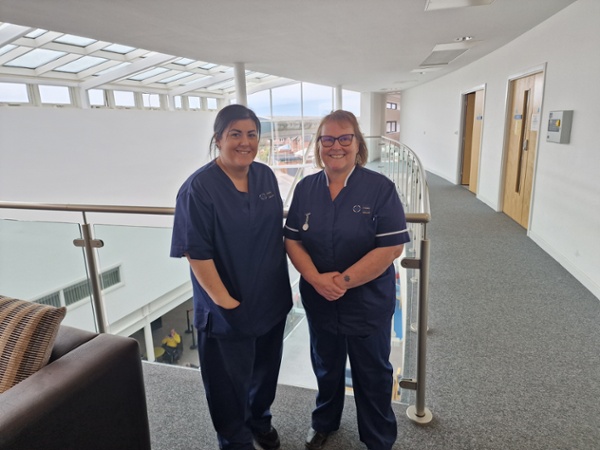Rollout sees more patients than ever benefiting from virtual wards

More patients than ever across Swansea Bay are benefiting from a service which provides care in their own homes rather than in hospital.
Virtual wards provide wraparound support in the community to people with complex health and social needs.
Rather than a ward being made up of hospital beds, the patients’ own beds become part of a virtual ward, meaning they still receive face-to-face care but in the comfort of their homes instead of a hospital.
A multi-disciplinary team made up of health and care professionals, such as doctors, nurses, pharmacists and therapists, discuss how to plan and manage each patient’s care, ensuring face-to-face assessment and intervention is completed.
Digital technology is used to pull the large teams together virtually, making communication and care planning more efficient and effective.
Remote patient monitoring is also being rolled out, alongside face-to-face assessment, to enhance patient care. Patients benefit from home based equipment to help monitor their physical health.
Managing and supporting patients within their own community helps to reduce the risk of infection and deconditioning associated with long hospital stays.
Pictured: Cheryl Griffiths and Jo Gwilym-Edwards.

It also takes the strain off hospitals by preventing avoidable admissions and paving the way for earlier discharges from hospital wards.
This allows patients to stay or return earlier to their familiar environments to receive care and recuperate following their hospital stay.
Swansea Bay University Health Board has made a significant investment to implement the virtual ward service model across the cluster areas.
Virtual wards were initially trialled in four of Swansea Bay’s local cluster collaboratives (LCCs) – Bay Health, Cwmtawe, Neath and Upper Valleys – which resulted in a reduction of hospital admissions.
Now, they have been introduced into the remaining four LCCs (Afan, City Health, Llwchwr and Penderi) ensuring equitable access for all residents across Swansea Bay.
More than 900 patients were referred directly to virtual wards by their GP between November 2021 and December 2022.
During that time, more than 330 hospital admissions were avoided as a result.
Jo Gwilym-Edwards, City Health virtual ward clinical manager, said: “The clusters with virtual wards were compared with the ones that didn’t and the statistics showed there were less hospital admissions in the clusters which did have virtual wards.
“It was decided to roll them out to the remaining four clusters.
“All of the GP surgeries within my cluster have been 100 per cent behind it and fully engaged.
“It’s been brilliant so far. We’ve seen lots of hospital avoidances and facilitated lots of early discharges from hospital.
“GPs see their patients and can see if they are starting to deteriorate or if they may need assistance.
“Some patients may be lonely, for example. There’s nothing GPs can do for them medically so they will refer them to us to see which services we can refer them into, such as voluntary services or contacting social prescribers.
“We have been able to improve the quality of life for lots of people who may be at a stage where their health is beginning to deteriorate.
“We are not there to replace any services that are already there – we are there to fill in the gaps.”
The virtual ward has also had a positive impact within the Afan LCC.
Since September, 253 patients have been referred to the virtual ward by GPs and secondary care staff.
Of that total, 121 hospital admissions were subsequently avoided.
Pictured: City Health LCC’s virtual ward team meet virtually.

Cheryl Griffiths, Afan LCC virtual ward clinical manager, said: “There has been a large number of patients that have been helped so far.
“We have carried out a lot of preventative work by supporting patients who may be frequent attenders at hospital.
“We ring them and introduce ourselves and identify if there is anything we can do to help them, and if so then we can go to their home and carry out a full assessment.
“When we contact patients we always explain our main aim is to prevent any further hospital admissions.
“In hospital they are at risk of deconditioning or picking up an infection, so preventing an avoidable hospital stay can make a big difference to them, as well as their family or carers.
“Working to help keep people at home and keep their independence is really important.
“We have support from GPs, consultants and the wider multi-professional team. Everyone coming together and sharing ideas and feedback is key to the virtual ward running so smoothly.”
Albert Piper, aged 96, was referred to the Afan LCC’s virtual ward due to his mobility issues and increasing frailty.
He was visited at his Port Talbot home by Cheryl and an occupational therapist who carried out assessments.
In doing so, they found he needed a review to amend current medications, extra equipment to help with his mobility and follow-up blood tests to monitor his physical health, among other things.
Mr Piper was taken to hospital for treatment and once stable, was discharged under the care of the virtual ward.
His wife Valerie said: “He was in and out of hospital for the last three or four years.
“He would get out of bed and I thought he was having a seizure. I was having to phone an ambulance regularly for him but it was put down to his blood pressure.
“A new medication he was put on started to make him ill, so the virtual ward staff came down to give him a blood test and do assessments.
“They reviewed his medication and changed it and that made big improvements.
“They were marvellous. I cannot fault them.”
Referrals received from primary care help to prevent avoidable hospital admissions.
While referrals from secondary care often mean the patient can be discharged earlier from hospital, as virtual ward staff can continue to monitor them.
“In secondary care, an example would be patients who have been diagnosed with heart failure,” Jo added.
“They would need to stay in hospital for around a week to check their congestion is reducing properly and the medication is correct for them.
“Now they can be sent home under the virtual ward and we can monitor them at home. We would check their bloods and weigh them to make sure progress is happening.
“That gets them out of hospital a week earlier so it frees up their bed and patients recover quicker at home too.
“We also have an in-reach team who identify patients on hospital wards and front door services such as A&E who may be suitable for virtual wards.”
Dr Ceri Todd, City Health LCC virtual ward GP, said: “The support delivered by the virtual ward team has resulted in optimisation of care and avoided hospital admissions for our most vulnerable patients.”
Dr Anjula Mehta, Deputy Medical Director for the health board, said: “The fast pace of rollout of the eight virtual wards and in-reach teams was needed to ensure quick, effective, appropriate wraparound care in the community for this specific patient cohort.
“We are making a difference to our patients and their families on a daily basis by stabilising and optimising their care to prevent admission or long hospital stays.
“Patients want and need to be home, and we are proud we can facilitate this care closer to home to improve our patients’ health and well-being.”
Rydym yn croesawu gohebiaeth a galwadau ffôn yn y Gymraeg neu'r Saesneg. Atebir gohebiaeth Gymraeg yn y Gymraeg, ac ni fydd hyn yn arwain at oedi. Mae’r dudalen hon ar gael yn Gymraeg drwy bwyso’r botwm ar y dde ar frig y dudalen.
We welcome correspondence and telephone calls in Welsh or English. Welsh language correspondence will be replied to in Welsh, and this will not lead to a delay. This page is available in Welsh by clicking ‘Cymraeg’ at the top right of this page.